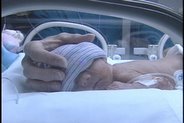 You can always tell the innovators for any industry. They are bold, creative and do things that their competitors only dream of doing.
You can always tell the innovators for any industry. They are bold, creative and do things that their competitors only dream of doing. ThermalNetics is one of those innovators. Already regarded as a progressive distributor of HVAC products, ThermalNetics furthered its reputation with a spectacular marketing event.
Billed as the 2007 Open House and Product Show Tailgate Party, the company hosted more that 400 customers at its new headquarters in
President Rick Sutkiewicz designed the event around a sports/tailgate theme. Guests were invited to try their hand at basketball free throws to win prizes. Three professional basketball players from the Detroit Pistons joined the party to share stories and sign autographs. As if that wasn’t enough the Piston’s cheerleaders, The Automotion Dance Team also performed for guests. Add live music and great food and you have an excellent draw.
The festive atmosphere provided the perfect platform for some serious business and networking. In addition to VIGILAIR, McQuay Industrial was on site to meet and greet potential customers. McQuay brought 2 tractor trailers to the event, each displaying its latest offering in commercial HVAC.
 But in an environment where the bottom drives many purchases, how can this event make sense? The answer to that question is found in ThermalNetics’ approach to the market place.
But in an environment where the bottom drives many purchases, how can this event make sense? The answer to that question is found in ThermalNetics’ approach to the market place.
Rick Sutkiewicz knows that each customer represents a relationship. Before the customer invests in ThermalNetics, ThermalNetics invests in the customer, gaining trust, demonstrating expertise and innovation.
Sure this event was a ton of fun, but it was also money and time well spent. VIGILAIR reps at the event made important contacts and were able to reach out to valuable decision makers.
As I write this the sun is warm and more than 300 people are enjoying live music, a cold drink and Bar-B-Q. Not one contract was signed, but millions in business was secured - one relationship at a time. And if you can’t see the value in that, you’re not an innovator.Check out more pictures from ThermalNetics' 2007 event by clicking on the image below:
 |
| ThermalNet |


